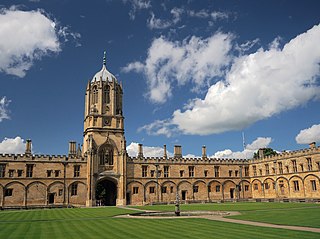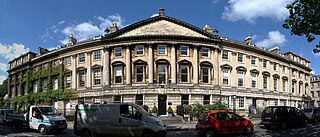
Christ Church is a constituent college of the University of Oxford in England. Christ Church is a joint foundation of the college and the cathedral of the Oxford diocese, which serves as the college chapel and whose dean is ex officio the college head.

Corpus Christi College is one of the constituent colleges of the University of Oxford in the United Kingdom. Founded in 1517, it is the 12th oldest college in Oxford.

Merton College is one of the constituent colleges of the University of Oxford in England. Its foundation can be traced back to the 1260s when Walter de Merton, chancellor to Henry III and later to Edward I, first drew up statutes for an independent academic community and established endowments to support it. An important feature of de Merton's foundation was that this "college" was to be self-governing and the endowments were directly vested in the Warden and Fellows.

St John's College is a constituent college of the University of Oxford. Founded as a men's college in 1555, it has been coeducational since 1979. Its founder, Sir Thomas White, intended to provide a source of educated Roman Catholic clerics to support the Counter-Reformation under Queen Mary.

Trinity College is one of the constituent colleges of the University of Oxford in England. The college was founded in 1555 by Sir Thomas Pope, on land previously occupied by Durham College, home to Benedictine monks from Durham Cathedral.

Mob Quad is a four-sided group of buildings from the 13th and 14th centuries in Merton College, Oxford, surrounding a small lawn. It is often claimed to be the oldest quadrangle in Oxford and elsewhere, although Merton's own Front Quad was actually enclosed earlier and Corpus Christi College, Cambridge, says that its own Old Court is the oldest structure of its type in either Oxford or Cambridge. The quadrangle pattern has since been copied at many other colleges and universities worldwide.

The Radcliffe Quadrangle is the second quadrangle of University College, Oxford, England. The buildings have been Grade I listed since 1954.

Christ Church Library is a Georgian building that forms the south side of Peckwater Quadrangle in Christ Church, Oxford, England. To the east is Canterbury Quadrangle. The library houses the college's modern lending library and early printed books on two floors.

The Great Quadrangle, more popularly known as Tom Quad, is one of the quadrangles of Christ Church, Oxford, England. It is the largest college quad in Oxford, measuring 264 by 261 feet. Although it was begun by Cardinal Wolsey in 1525–1529, he was unable to complete it before his fall from power.

The Meadow Building is part of Christ Church, Oxford, England, one of the Oxford colleges, looking out south onto Christ Church Meadow on Broad Walk and then along the straight tree-lined Poplar Walk to the River Thames.

The Blue Boar Quadrangle is a quadrangle at the University of Oxford's Christ Church. It was designed by Hidalgo Moya and Philip Powell, and built between 1965 and 1968. The quadrangle has been described as "One of the best buildings of its kind during the expansion of higher education" by Lord McIntosh of Haringey, Minister for Culture, Media and Sport. The quadrangle has held the classification of Grade II* listed building since 17 October 2006, a status shared by only 20,000 other structures in the country due to the unique nature of its 1960s architecture. Blue Boar underwent a substantial renovation from 2007 to 2008, resulting in the conversion of all rooms to modern en-suites.

Blue Boar Street is a narrow historic street running between St Aldate's to the west and the southern end of Alfred Street to the east, in central Oxford, England. It is located just north of Christ Church.

St Frideswide's Priory was established as a priory of Augustinian canons regular, in 1122. The priory was established by Gwymund, chaplain to Henry I of England. Among its most illustrious priors were the writers Robert of Cricklade and Philip of Oxford. The original nunnery founded by Frideswide was destroyed in 1002. After that there was a monastery of Augustinian canons.

In architecture, a quadrangle is a space or a courtyard, usually rectangular in plan, the sides of which are entirely or mainly occupied by parts of a large building. The word is probably most closely associated with college or university campus architecture, but quadrangles are also found in other buildings such as palaces. Most quadrangles are open-air, though a few have been roofed over, to provide additional space for social meeting areas or coffee shops for students.

English Gothic is an architectural style that flourished from the late 12th until the mid-17th century. The style was most prominently used in the construction of cathedrals and churches. Gothic architecture's defining features are pointed arches, rib vaults, buttresses, and extensive use of stained glass. Combined, these features allowed the creation of buildings of unprecedented height and grandeur, filled with light from large stained glass windows. Important examples include Westminster Abbey, Canterbury Cathedral and Salisbury Cathedral. The Gothic style endured in England much longer than in Continental Europe.

Queen Square is a square of Georgian houses in the city of Bath, England. Queen Square is the first element in "the most important architectural sequence in Bath", which includes the Circus and the Royal Crescent. All of the buildings which make up the square are Grade I listed.
Vine Hall was an academic hall of the University of Oxford, located on Alfred Street in the 16th century. It became a part of the Peckwater Quadrangle of Christ Church, Oxford. The building gave its name to the previous name for Alfred Street, particularly the southwards continuation of it; Vine Hall Lane. Some have said that the current name Alfred Street is of unknown aetiology and pointless, and the street should be renamed Vine Hall Lane. It was previously known as St Edward's Lane, but the name Vine Hall Lane was in use by 1576.

The main buildings of Jesus College, one of the colleges of the University of Oxford, are located in the centre of the city of Oxford, England, between Turl Street, Ship Street, Cornmarket Street, and Market Street. Jesus College was founded in 1571 by Elizabeth I caused by the petition of a Welsh clergyman, Hugh Price, who was treasurer of St David's Cathedral. Her foundation charter gave to the college the land and buildings of White Hall, a university hall that had experienced a decline in student numbers. Price added new buildings to those of White Hall, and construction work continued after his death in 1574. The first of the college's quadrangles, which includes the hall, chapel, and principal's lodgings was completed between 1621 and 1630. Construction of the second quadrangle began in the 1630s, but was interrupted by the English Civil War and was not completed until about 1712. Further buildings were erected in a third quadrangle during the 20th century, including science laboratories, a library for undergraduates, and additional accommodation for students and fellows. In addition to the main site, the college owns flats in east and north Oxford, and a sports ground.

St Lawrence's Church is an Anglican parish church at Mereworth, Kent, United Kingdom. It is in the deanery of West Malling, the Diocese of Rochester and Province of Canterbury. The church was built in the mid-1740s by John Fane, the 7th Earl of Westmorland, following his removal of the village's 12th century place of worship to allow for the enlargement of Mereworth Castle.

The Canterbury Quadrangle is one of the quadrangles of Christ Church, Oxford, England. It stands on the site of the former Canterbury College.























